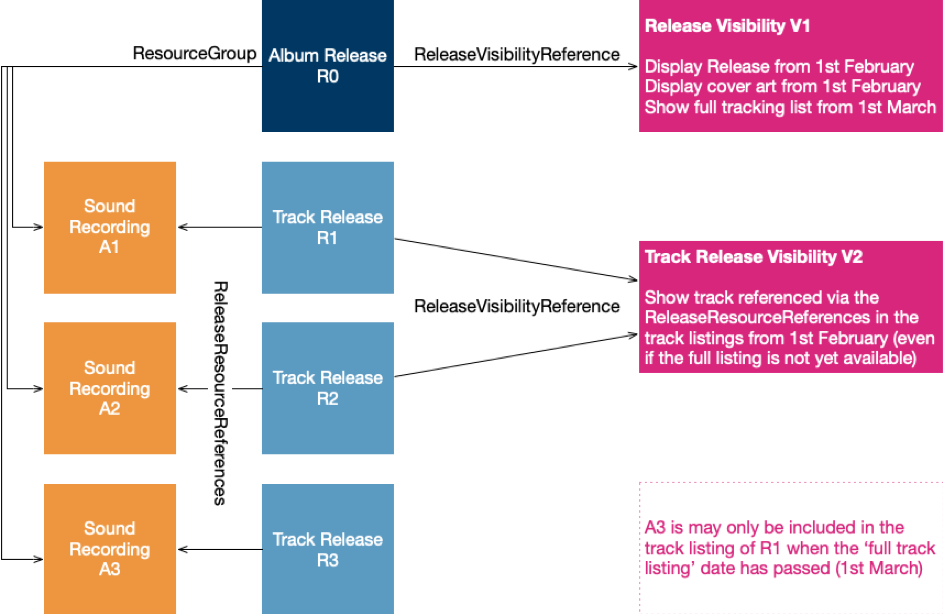Availability and visibility
Release availability
A NewReleaseMessage provides information about a release, its constituent resources and how it can be made available to consumers.
The latter aspect is what is usually referred to as “a deal”. Deals are communicated in the ReleaseDeal composite. One aspect of such deals is the date and/or time from when (and until when) a DSP may make a Release available under specific terms and conditions. A simple deal allowing a Release to be available as a permanent download from 1st May 2020 onwards might look like this:
<DealTerms>
<ValidityPeriod>
<StartDateTime>2020-05-01T00:00:00Z</StartDateTime>
</ValidityPeriod>
<UseType>NonInteractiveStream</UseType>
</DealTerms>
Release visibility
There are, however, further dates for a DSP to observe when it comes to showing a release to consumers. This is in addition to the DSP making available the release and is particularly used by record companies when releasing brand new albums.
These aspects are:
From which date/time is the DSP allowed to show any information about a release and its constituent resources?
From which date/time is the DSP allowed to show the cover art of a release?
From which date/time is the DSP allowed to show the track listing of the release?
These aspects are communicated in a number of additional tags whose placement has changed between ERN 4.1 (and earlier), and ERN 4.2 (and later). Whereas in the earlier versions these attributes are part of the DealTerms, they are now collated in a separate composite referenced from the Release. The example below indicates that the information about the Release itself can be shown from 1st February. At the same time the cover art may be shown but the track listing may only be shown on 1st March.
Example for ERN 4.1
<DealList>
<ReleaseDeal>
<DealReleaseReference>R1</DealReleaseReference>
<Deal>
<DealTerms>
<ValidityPeriod>
<StartDateTime>2020-05-01T00:00:00Z</StartDateTime>
</ValidityPeriod>
<UseType>NonInteractiveStream</UseType>
<ReleaseDisplayStartDateTime>2020-02-01T00:00:00Z
</ReleaseDisplayStartDateTime>
<TrackListingPreviewStartDateTime>2020-03-01T00:00:00Z
</TrackListingPreviewStartDateTime>
<CoverArtPreviewStartDateTime>2020-02-01T00:00:00Z
</CoverArtPreviewStartDateTime>
</DealTerms>
</Deal>
</ReleaseDeal>
</DealList>
Example ERN 4.2
(Note that the album Release with a ReleaseReference of R1 in the ReleaseDeal contains a tag, ReleaseVisibilityReference, pointing to the ReleaseVisibility composite “V1”.)
<DealList>
<ReleaseDeal>
<DealReleaseReference>R1</DealReleaseReference>
<Deal>
<DealTerms>
<ValidityPeriod>
<StartDateTime>2020-05-01T00:00:00Z</StartDateTime>
</ValidityPeriod>
<UseType>NonInteractiveStream</UseType>
</DealTerms>
</Deal>
</ReleaseDeal>
<ReleaseVisibility>
<VisibilityReference>V1</VisibilityReference>
<ReleaseDisplayStartDateTime>2020-02-01T00:00:00Z
</ReleaseDisplayStartDateTime>
<CoverArtPreviewStartDateTime>2020-02-01T00:00:00Z
</CoverArtPreviewStartDateTime>
<FullTrackListingPreviewStartDateTime>2020-03-01T00:00:00Z
</FullTrackListingPreviewStartDateTime>
</ReleaseVisibility>
</DealList>
See here for a complete sample:
Showing selected tracks in the track listing
In addition, ERN 4.2 also allows individual tracks to be included or excluded from the visible track listing by adding, for instance:
<TrackReleaseVisibility>
<VisibilityReference>V2</VisibilityReference>
<TrackListingPreviewStartDateTime>2020-02-01T00:00:00Z
</TrackListingPreviewStartDateTime>
</TrackReleaseVisibility>
into the DealList shown above.
This allows R1’s track listing to show all tracks whose TrackRelease pointing to V2 from 1st February onwards, one month before the full track listing may be seen by consumers. In the meantime, the DSP is expected to show that there are still tracks, whose titles are yet to be made public, missing from the track listing.
The different pointers in the ERN message are depicted below:
Reasonable visibility dates
As shown above, DSPs may need to observe different sets of start date/times when showing and making available Releases to consumers. Clearly not all combinations are sensible and some rules should be observed, e.g.:
The visibility dates only make sense on or before the start date of the
Dealitself (also known as “street date”). A visibility date later than the start date of theDealmay be deemed as invalid by the message recipient; andAn individual track’s
TrackListingPreviewStartDateTimelater than an album’sFullTrackListingPreviewStartDateTimemay lead to tracks being listed earlier than anticipated;Etc.
